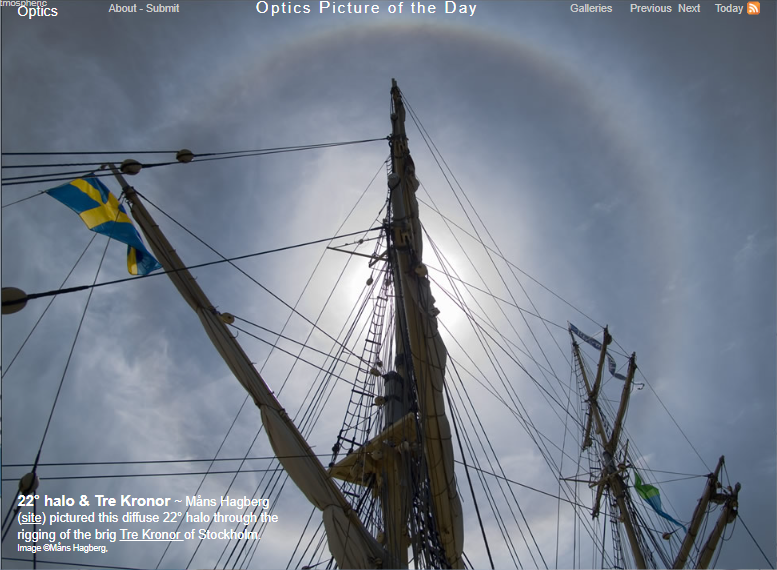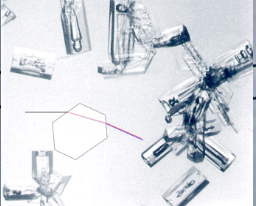OPOD - 22° halo & Tre Kronor, Stockholm
OPOD - 22° Halo & Tre Kronor, Stockholm: A Spectacular Atmospheric Optics Phenomenon
The atmospheric phenomenon known as the 22° halo is a captivating sight that often graces the skies, leaving onlookers in awe of its beauty. While most halos are formed by ice crystals with simple geometric shapes, the 22° halo is unique in its composition. In this article, we will delve deeper into the intricacies of this mesmerizing optical phenomenon and its connection to the stunning image of the brig Tre Kronor in Stockholm captured by Måns Hagberg.
Unraveling the Complexity of Halo Formation
The majority of halos are created by hexagonal prisms or hexagonal prisms with pyramidal ends, which are oriented in a specific manner due to aerodynamic drag forces as they descend through the atmosphere. However, the 22° halo stands apart from the rest. Its formation necessitates hexagonal prisms with a random or near-random orientation within the clouds, presenting a unique challenge for atmospheric scientists.
The Role of Cluster Crystals
To understand the formation of the 22° halo, we must explore the concept of cluster crystals. These crystals consist of several joined hexagonal columns, with each column element contributing to the creation of the halo. As light passes through these prism faces, inclined at an angle of 60° to each other, it undergoes a minimum deflection of approximately 22°. This deflection gives rise to the inner red edge of the halo, while additional light is refracted into larger angles, enhancing the halo's overall appearance.
The Intricate Dance of Light and Ice Crystals
The interplay between light and ice crystals is a crucial factor in the formation of halos. As sunlight passes through these ice crystals suspended in the atmosphere, it undergoes refraction and reflection, resulting in the stunning optical displays we witness. The precise orientation and shape of the crystals dictate the characteristics of the halo, including its size, shape, and coloration.
The Brig Tre Kronor: A Serendipitous Backdrop
The image captured by Måns Hagberg beautifully combines the ethereal allure of the 22° halo with the majestic presence of the brig Tre Kronor in Stockholm. The diffuse halo can be seen delicately peeking through the rigging of the ship, adding a touch of enchantment to an already captivating scene. This fortuitous juxtaposition serves as a testament to the awe-inspiring beauty that nature can bestow upon us.
The Wonders of Atmospheric Optics
Atmospheric optics is a fascinating field of study that explores the intricate mechanisms behind the various optical phenomena observed in the sky. From rainbows to halos, these phenomena offer glimpses into the complex interactions between light, particles, and atmospheric conditions. Scientists and enthusiasts alike continue to unravel the mysteries of these captivating displays, expanding our knowledge and appreciation of the natural world.
Capturing Nature's Artistry
Photographers and skywatchers around the world find joy in capturing these elusive atmospheric phenomena through their lenses. The image of the 22° halo and Tre Kronor serves as a testament to the power of photography in preserving and sharing these ephemeral moments of natural beauty. It reminds us of the importance of observing and appreciating the wonders that surround us, even in the most unexpected places.
The Evolution of Science Communication
In today's digital age, the dissemination of scientific knowledge has become more accessible than ever before. Platforms like OPOD (Optics Picture Of the Day) provide a valuable space for photographers, scientists, and enthusiasts to share their observations and insights with a global audience. Through these platforms, we can collectively marvel at the wonders of our universe and foster a deeper understanding of the intricate workings of nature.
Unlocking the Secrets of the Skies
While we have made significant progress in understanding atmospheric optics, there is still much to explore and unravel. The study of these phenomena not only deepens our scientific understanding but also ignites our curiosity and sense of wonder. As we continue to delve into the mysteries of the skies, we uncover new layers of complexity and gain a greater appreciation for the beauty that surrounds us each day.
Embracing the Splendor of Nature
The 22° halo and the image of Tre Kronor serve as gentle reminders of the extraordinary beauty that exists in the world around us. Whether it be through scientific inquiry, artistic expression, or simple moments of contemplation, let us embrace the splendor of nature and find inspiration in its ever-unfolding wonders. As we gaze upon the skies, may we be filled with a sense of awe and gratitude for the remarkable tapestry of life that envelops us all.

22° halo & Tre Kronor ~ Måns Hagberg (site) pictured this diffuse 22° halo through the rigging of the brig Tre Kronor of Stockholm. Image ©Måns Hagberg,
Nearly all of the halos are made by simple geometry ice crystals. They are plate or column habit hexagonal prisms or hexagonal prisms with pyramidal ends.
Not so the most common halo of all. That halo needs hexagonal prisms with random or near random orientation in the clouds. The difficulty is that the simple crystals, unless too small to form halos, are oriented rather precisely by aerodynamic drag forces as they drift slowly downwards relative to local air currents. Short stubby crystals might tumble but they are rarely sampled in significant concentrations.
The 22° halo culprits are more likely cluster crystals of several joined hexagonal columns. Each column element acts to form the halo. Light passes between prism faces inclined 60° to each other to undergo a minimum deflection of ~22°. That forms the halo’s inner red edge but more light is also refracted into larger angles.

Cluster crystals imaged at the South Pole by Walter Tape.
Note: this article has been automatically converted from the old site and may not appear as intended. You can find the original article here.
Reference Atmospheric Optics
If you use any of the definitions, information, or data presented on Atmospheric Optics, please copy the link or reference below to properly credit us as the reference source. Thank you!
-
<a href="https://atoptics.co.uk/blog/opod-22-halo-tre-kronor-stockholm/">OPOD - 22° halo & Tre Kronor, Stockholm</a>
-
"OPOD - 22° halo & Tre Kronor, Stockholm". Atmospheric Optics. Accessed on November 26, 2024. https://atoptics.co.uk/blog/opod-22-halo-tre-kronor-stockholm/.
-
"OPOD - 22° halo & Tre Kronor, Stockholm". Atmospheric Optics, https://atoptics.co.uk/blog/opod-22-halo-tre-kronor-stockholm/. Accessed 26 November, 2024
-
OPOD - 22° halo & Tre Kronor, Stockholm. Atmospheric Optics. Retrieved from https://atoptics.co.uk/blog/opod-22-halo-tre-kronor-stockholm/.